As we make our way east along the north shore of Crete, we had planned just a three-day stop in the small, pretty city of Rethymno. At first, the weather forecast of rain and thunderstorms for our entire visit was nothing more than a disappointment. “We’ll go out between downpours – how bad can it be?”
When we found out that a rare “medicane”(Mediterranean hurricane) had done significant damage to some of the northern mainland and a couple of the Ionian islands and was headed for Crete, we took notice. However, lucky us, Crete got a pass from the worst of the storm. Our first night in Rethymno was rainy but the rest of our stay has been ideal – big dramatic skies and cooler temperatures. We have had the chance to see everything we wanted to see in the area, although weather closed the local beaches.
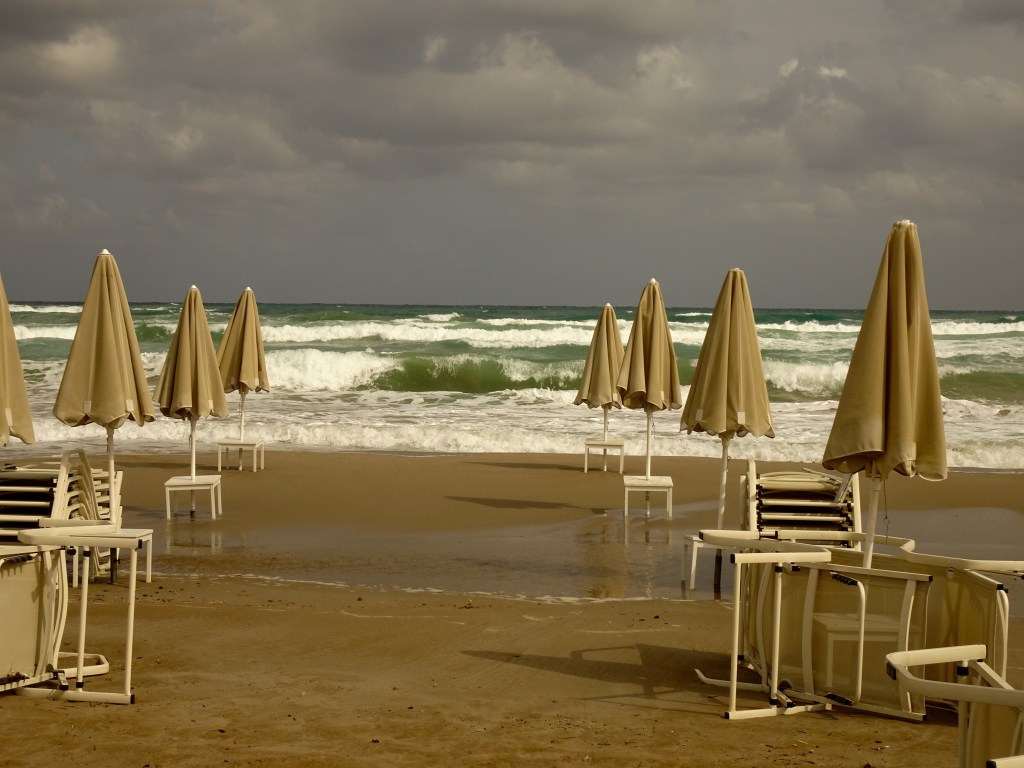
Rethymno is a delightful, smaller version of Chania – charming old town, narrow alleyways, Venetian and Ottoman influences and the harbour and lighthouse as a focal point.
We lucked out with our Airbnb – a spacious one-bedroom apartment on the top floor, with a broad balcony that overlooked the rooftops.
The view from our balcony looking down to the street below. We heard muted music and people’s voices, but otherwise, it was very quiet. And so clean: this morning we woke up to the sound of a street cleaner who was slowly moving along the road, vacuuming up cigarette butts and bits of garbage.

It seems the common denominator in every village, town and city in Greece is a large and well-cared-for cat population. They are neither friendly nor skittish – they just exist as part of the landscape; something I find quite endearing.

Laneways are another enchanting feature of Rethymno; you can get turned around, but never totally lost. All roads lead to a central square or the harbour or the main shopping street, so the challenge is just deciding whether to turn left or right.
We had fun watching the little boy trying to figure out his bike and was doing just fine until his older brother came along to help.

A typical small cafe tucked into an alley.
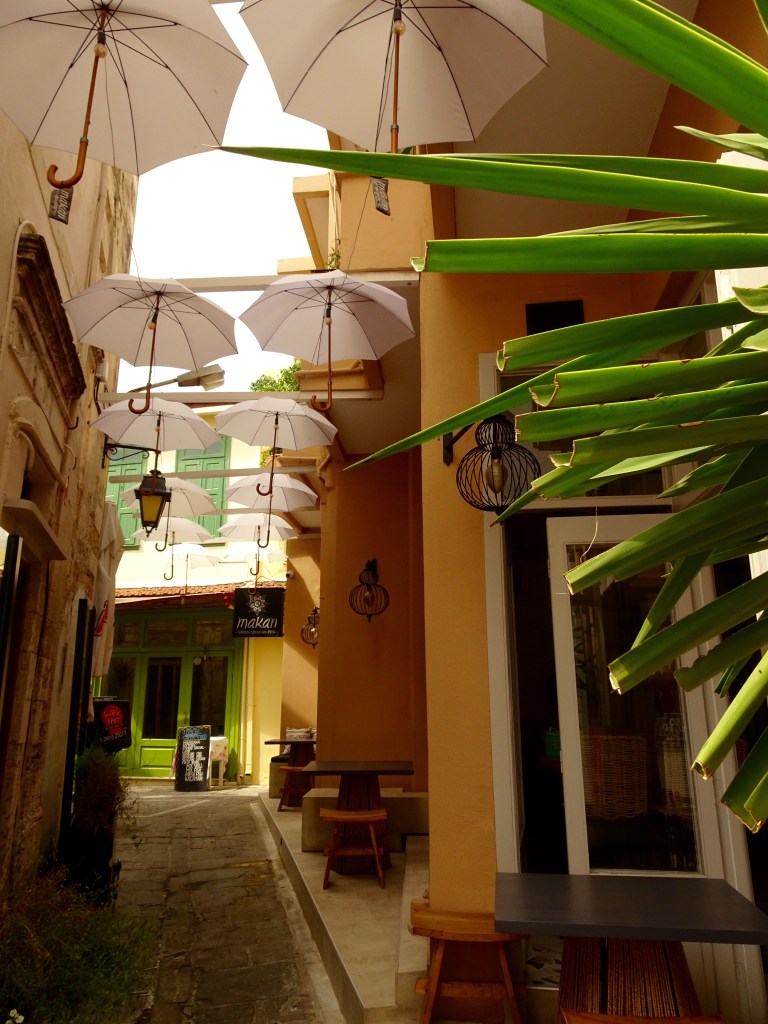
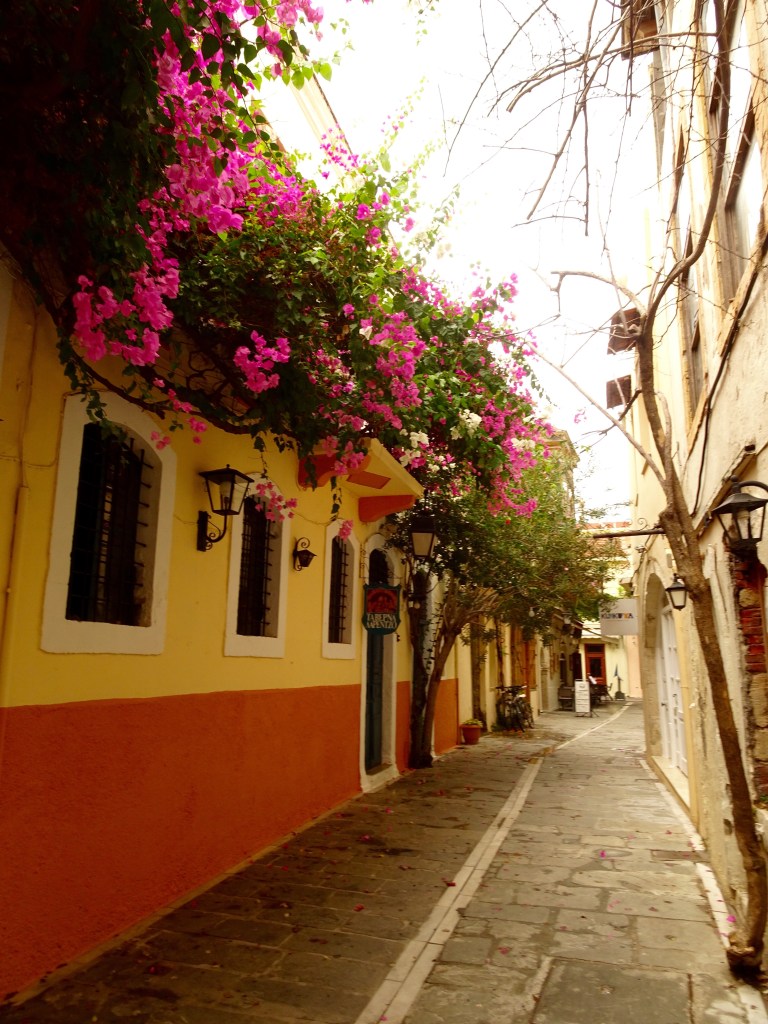
I loved these plant hangers. I know they fall into the “harder-than-it-looks” category, but I would love to try nailing together a number of small, flat boards and construct one of these for our balcony back home.

You know when you have set certain expectations for a recommended tourist site? The Rimondi Fountain was described as being a dramatic stone fountain set in a square. Visitors were urged to drink the fresh spring water from the fountain “to ensure your return to Rethymno”.
Well, I must have had an image of something along the scale of the Trevi Fountain, so we actually walked right past this once before we asked for directions and made our way back.
Other confused tourists were also dutifully snapping photos, but it was an underwhelming site. Even worse, there was no tap for fresh spring water, which I hope does not jinx our chances of returning.

All other sites in Rethymno more than made up for this. Some, like this modest building, just told a simple story.
During the 17th century, this building was one of two public baths (or hamams) in Rethymno, built by the Turks. It was a functioning hamam until 1925, and then became a bakery for many years. It was extensively restored and from 2000 on, was designated a protected site and became a hamam again.

Turkish architecture features prominently in Rethymno. Unique features include upper storeys that project out over the street by perhaps an additional two to three feet and are embellished with heavy wood and latticework.

This is a common site in Reythmno – the juxtaposition of original buildings beside renovated ones. The newer builds are still faithful to the architectural features of the old – just with better windows and more secure railings.

Rethymno is filled with many notable mosques and churches. I apologize for the lack of proper identification of the church – I took so many photos, and now am completely confused. They are all a variation on a theme, though – solid, understated elegance.

Neratzes Mosque

This mosque fronts onto a square that is flanked on one side by a park and on the other side by this mural. We walked out of the square into a neighbourhood that was filled with graffiti – all of it in Greek, with the exception of the obligatory “Fuck the Police“, but the tone had changed. Far less Instagram-worthy, not intended for tourist eyes, it was a lot more reflective perhaps of the struggles many Greeks have lived with for years.
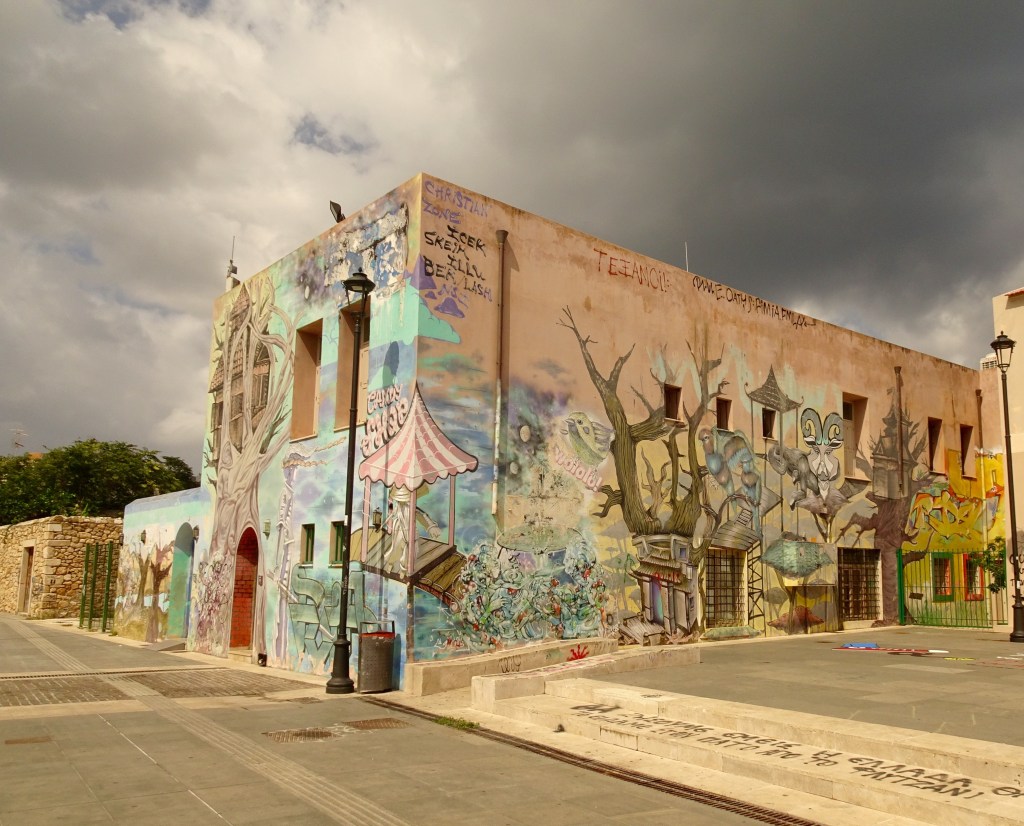
Food has played an important part in our stay in Reythmno. The day we arrived, we hit the streets around 3:30 or 4:00, and before long, it began to rain. We took refuge in this restaurant, and snug as could be, we sat under the awning and watched the world go by (run by?), as we enjoyed snacks and beer.
We enjoyed it so much, we returned again last night for dinner.

Before our arrival, I had read about RakiBaRaki a number of times. It was fabulous – every dish an inventive variation on traditional Greek mezes. I ordered mussels in ouzo, and Stephen had a charcuterie board with pork belly, eggplant salad and a flavoured cream cheese. Heavenly food, and sadly, my photos did not turn out well, but this is the restaurant.

It is common in Greece to have Menus for 2, to allow diners to try a variety of dishes. We ordered the Mixed Mezes, which offered six dishes – tzatziki, green pepper stuffed with rice, eggplant with beef and cheese, chicken with lemon and wine, beef and onions and horta (wild greens). Delicious and impossible to finish. We can’t eat like this every day – all the walking we’re doing will not make a dent. Also it doesn’t stop there. Complimentary fruit, desserts and/or ouzo arrive on the table after every meal.
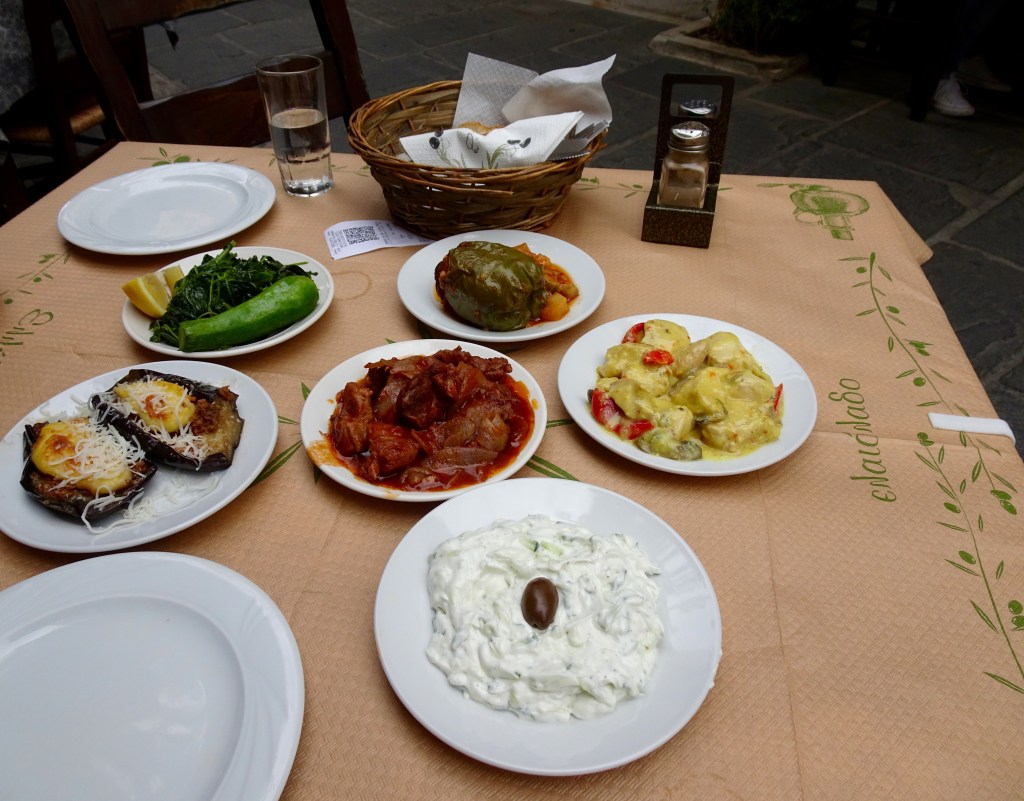
Coffee shops abound – everything from the tiny Greek coffee stands to the larger coffeehouses. Coffee fredo is big here – iced cappucinos that are a perfect excuse to grab a waterfront table and get out of the sun for a bit.
There are even Starbucks in Greece, but honestly why would you bother when you could check out this coffeehouse?

Remember worry beads? They are very likely making a comeback during these trying times, and there are at least a couple of tiny stores in Rethymno that specialize in them. Gorgeous beads made of polished wood or semi-precious stones or a tiny set of beads to attach to your key chain.
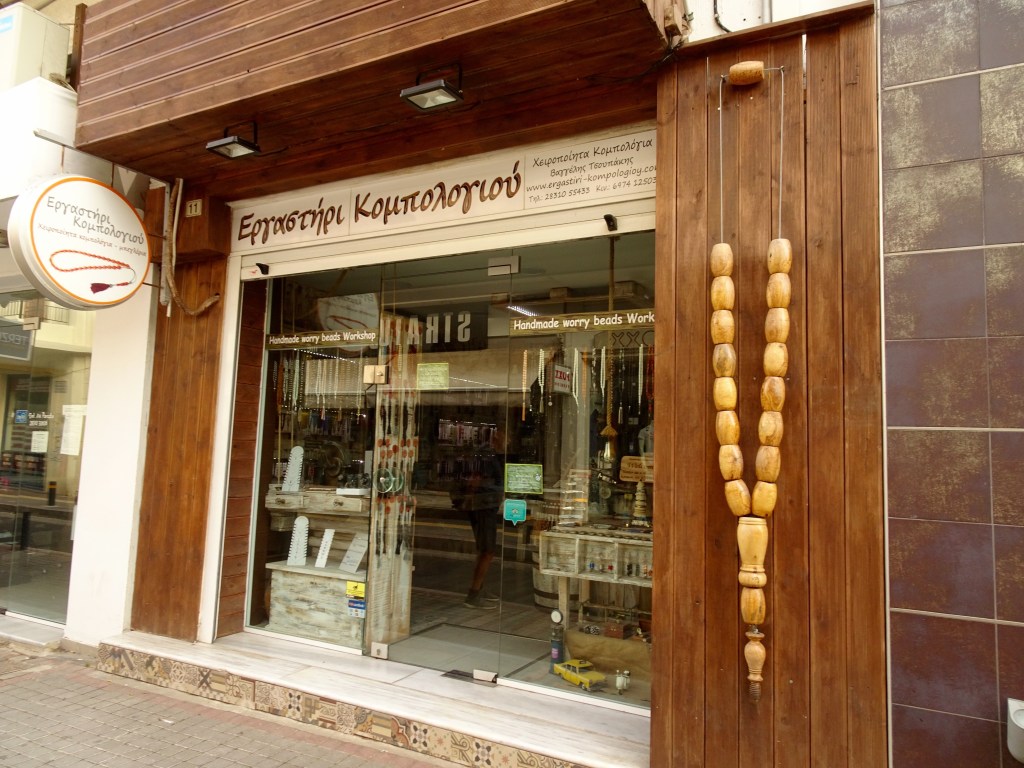
I could go on about the amazing shopping – the gorgeous linens, the colourful prints, the authentic artifacts, the polished olivewood, stunning leather bags, fabulous shoes and inventive jewellery. And that is just what you could pack in a suitcase. Therein lies the rub.
We are both travelling in our usual fashion – with carry-ons that are already filled to the brim. If I start buying things now, I have another month to schlep everything with me, so I am trying to resist and hoping that what we are finding here will also be available in other parts of Greece, closer to our departure time. Next time – I’m bringing a full-size rollie.
Rethymno’s waterfront is quite different from that of Chania, although it is Venetian in style.

The Egyptian lighthouse is part of the harbour, but does not enclose and protect it. The sea is wide open beyond that.
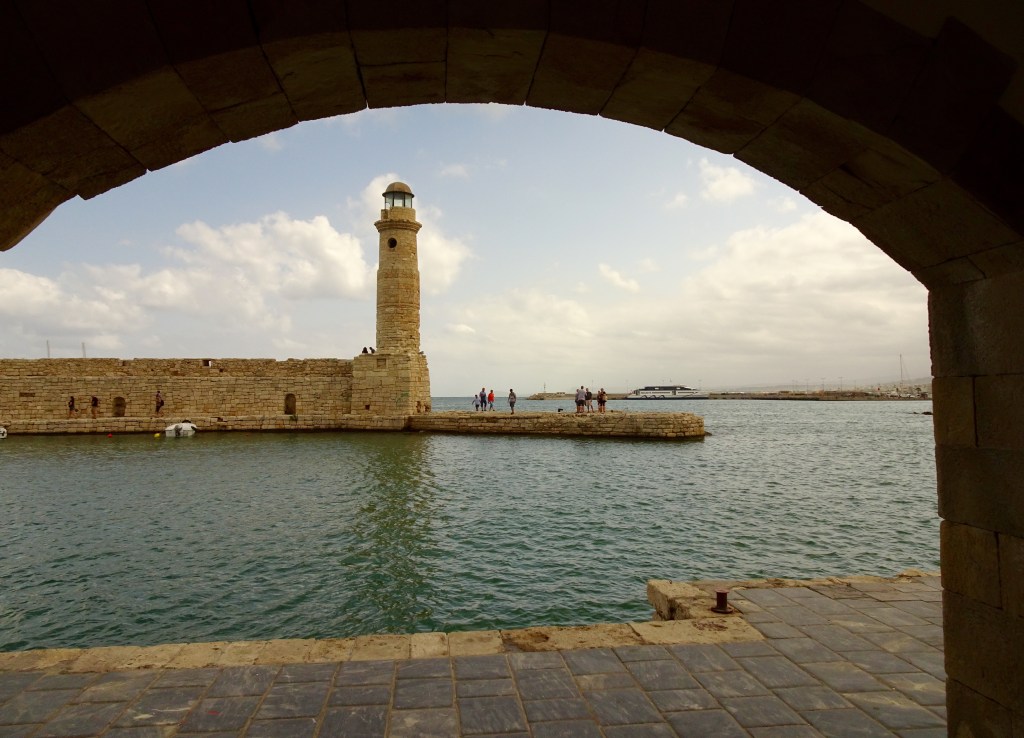
These intriguing concrete sculptures are part of the harbour. I couldn’t find any information about them, but I assume they are intentionally decorative as well as providing a significant barrier in rough weather.

The Fortezza, which holds a place of prominence on the hill overlooking the sea, was built in the 16th century by the Venetians to protect its citizens from Ottoman invasions. After the surrender to the Ottomans in 1646, it retained much of its character and the number of residents increased dramatically.
When the Germans occupied during World War II, it was used as a prison and dormitories. After the war, much of the Fortezza was demolished and since then there has been great effort to restore and maintain the remaining buildings.
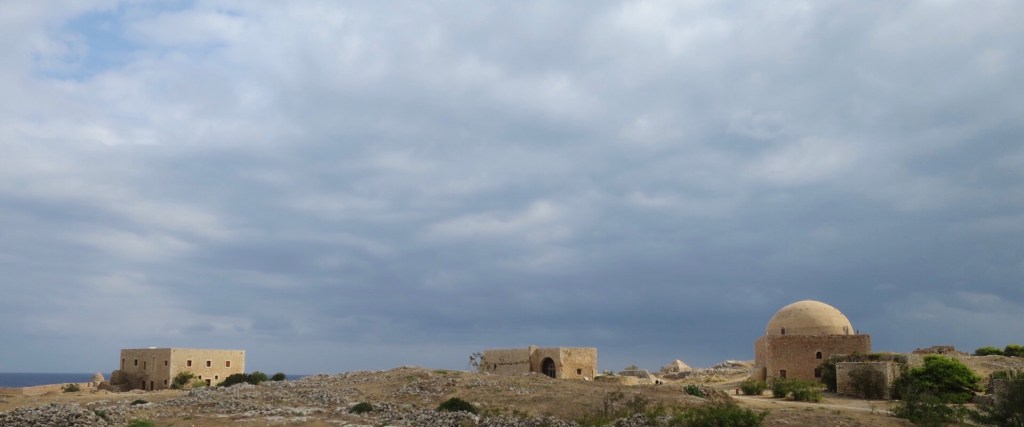
We spent over an hour wandering the site, made all the more pleasurable due to the lack of crowds and the cooler temperatures.
We began by walking up one of the bastions to gain an overall view of the Fortezza, the city and the sea.

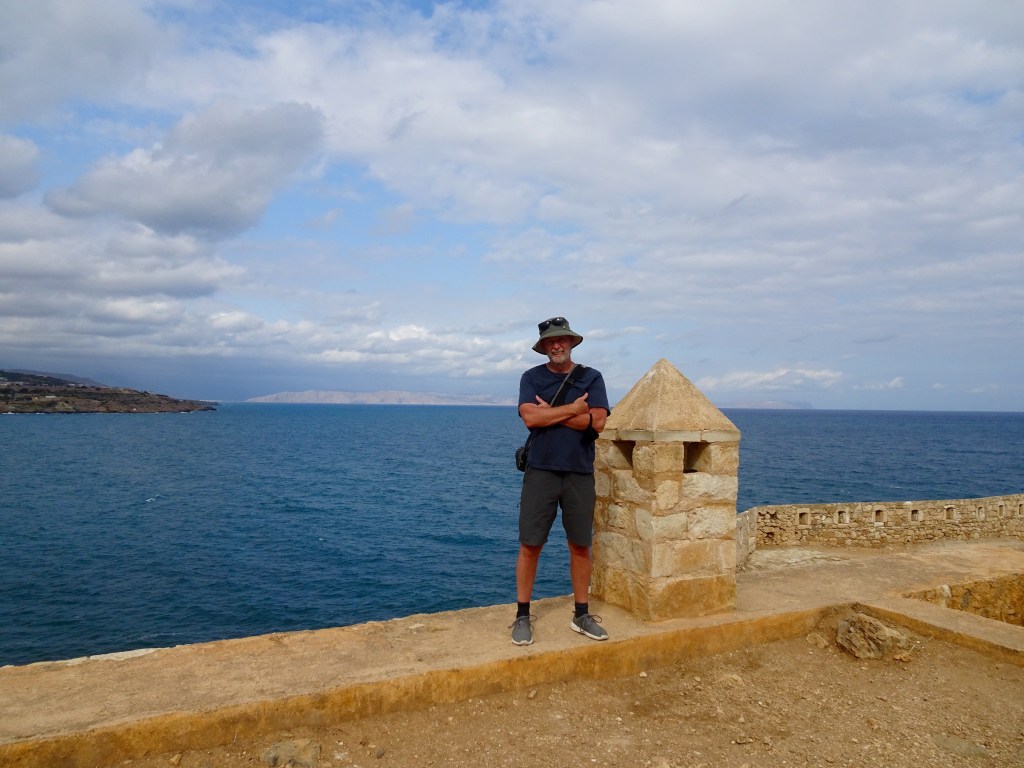
Once the Fortezza was seized by the Ottomans, they built this mosque. Today it is used for exhibitions and music events.

The incredible mosaic ceiling of the mosque.

The warehouse complex that consisted of three domed covered and two uncovered spaces for food and tanks.

The Twin Building that was used for storage and is now used as an exhibition venue.
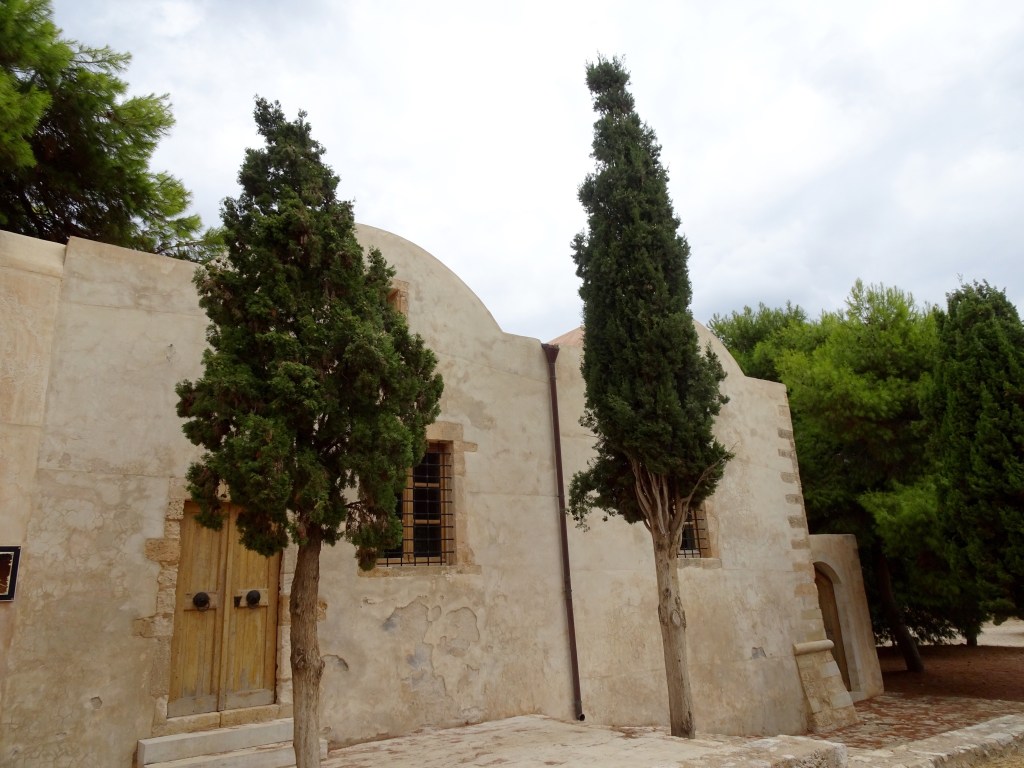
St. Theodor Trichinas’ Temple
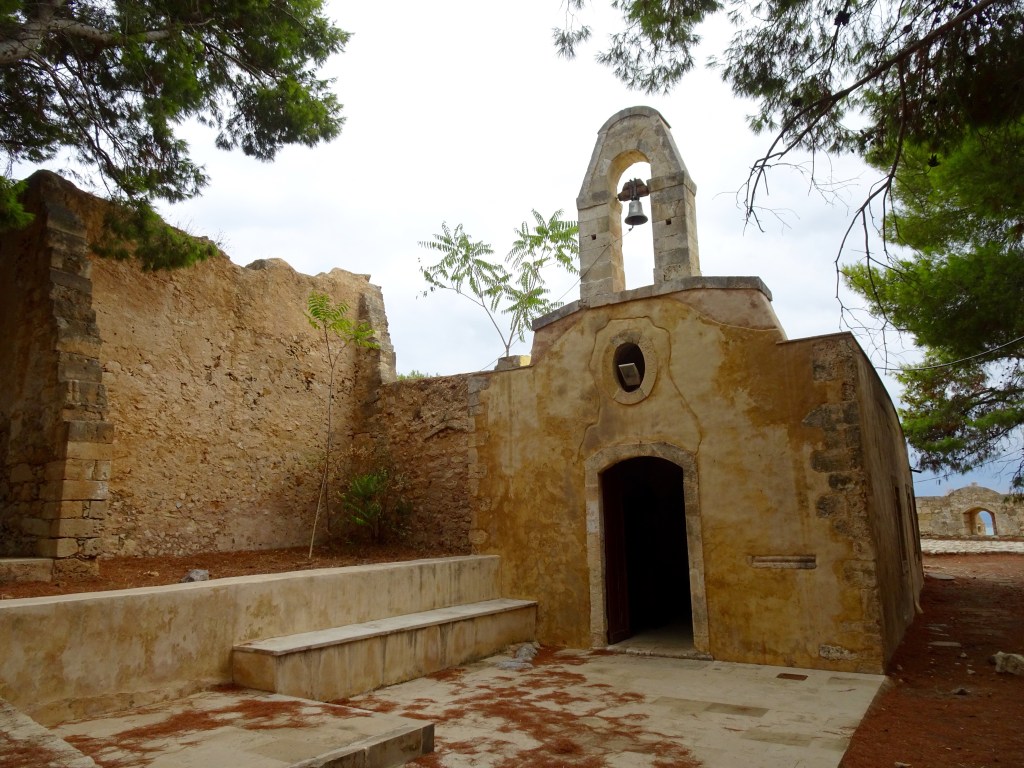
And so our short, but sweet time in Rethymno has come to an end. Tomorrow we hop on a bus to Heraklion, then grab a rental car for one week as we begin to explore the east side of Crete.
Loving following leavingourselvesbehind again ….memories of our adventures in Crete are flooding back . We got lost exploring ‘outside Chania’ and ended up in a little village drinking Raki in a taverna with the local farmers and fishermen.
Moving around the little villages in a wheelchair made for many hilarious stories all emphasizing how kind and helpful the Cretan people are.
LikeLike
Oh I can just picture it all! Raki pretty much goes with everything, and would definitely help with navigation on terrain that is barely doable, even for the goats.
LOVE Crete!
LikeLike
Lovely.
LikeLike
Thanks Joy! Have you guys been here?
LikeLike
Ginny, you didn’t mention your back and it seems like you are back to hiking. Is all well?
LikeLike
My back is about 85% now, thanks. The other 15% accounts for when I overdo it, but mainly I am able to tear around like before.
LikeLike
Hi Ginny,
It’s interesting to see how the grey skies affect the colour of the water, which here is a darker turquoise. But seeing how people are dressed, the temperature must be perfect for exploring. How lovely it all looks!
It seems to me that I’ve seen those cement shapes protecting the harbour somewhere before though don’t remember where. They remind me of jacks. I think they are meant to be more functional than esthetic, the shapes interlocking to make them better withstand being dislodged by the stormy seas.
I hope your back is getting better. I’ve had similar muscle spasms and walking seems to be something one can still do, but not overdo!
LikeLike
Jacks! That is exactly what they look like – I was trying to place that familiar shape.
My back is much better thanks! I walked up and down a flight of 185 steps to the beach today without a twinge, so I think I’m getting there. Good thing – Crete is very hilly.
LikeLike
Fascinating and lovely, glad the weather is cooperating to make your travels easier, the cloudscapes make for some dramatic photos, thanks for sharing Ginny, take good care. 🙂
LikeLike
Thanks Garry – nice to hear from you. I’ve been thinking about you and Donna during these times, wondering how you are coping being away from the stage.
LikeLike
Thanks Ginny, Donna has been keeping engaged with Gabriola players, they just finished two short plays written by members, and played “live” on line, it was a big success, and today we celebrated our 2nd anniversary, so we’re feeling pretty smug about everything, so far so good. Hope you and Stephen are keeping safe and well, as ever we’re enjoying following you around as you see the world. Hugs from us!
LikeLike
What a wonderful portrait of Rethymno! More nostalgia for us. We’re so pleased that you enjoyed Raki Ba Raki as much as we did, and the photo of another cafe where you stopped looks familiar. So many places to drink and dine. We’re also glad to hear your back is getting better, Ginny. Crete is not exactly prairie flat. Take care and keep your beautiful pictures and detailed descriptions coming. You are travelling for us.
LikeLike
You know, drinking raki at lunch and again at dinner is perhaps a habit we need to watch! We finish our meal and they bring out those sweet little cut glass mini-decanters and two tiny glasses – why would we say no? We do this all for you! :>)
LikeLike
Rethymno looks like another intriguing place to visit! A lovely blend of strolls, history, shops, followed up by a leisurely dinner at one of the many restaurants that the city has to offer … sounds like my kind of place! Glad to hear you are on the mend so you can enjoy the sights!
LikeLike
Heather – you would love it here! I hope we find our way back here – so much to see and do and not enough time.
LikeLike